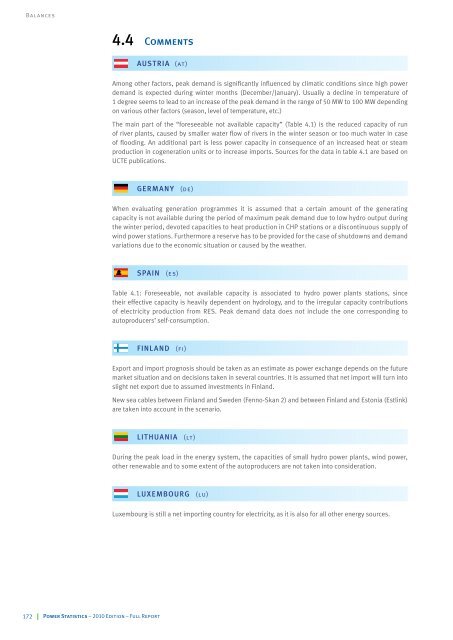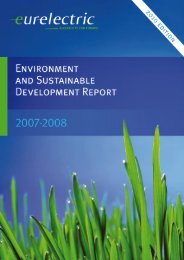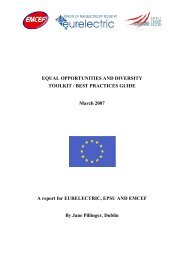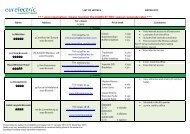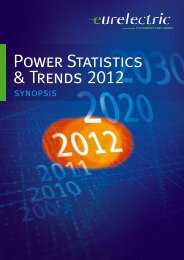Power Statistics - 2010 Edition - Full Report - Eurelectric
Power Statistics - 2010 Edition - Full Report - Eurelectric
Power Statistics - 2010 Edition - Full Report - Eurelectric
You also want an ePaper? Increase the reach of your titles
YUMPU automatically turns print PDFs into web optimized ePapers that Google loves.
Balances<br />
4.4 Comments<br />
172 <strong>Power</strong> <strong>Statistics</strong> – <strong>2010</strong> <strong>Edition</strong> – <strong>Full</strong> <strong>Report</strong><br />
AUSTRIA (at)<br />
Among other factors, peak demand is significantly influenced by climatic conditions since high power<br />
demand is expected during winter months (December/January). Usually a decline in temperature of<br />
1 degree seems to lead to an increase of the peak demand in the range of 50 MW to 100 MW depending<br />
on various other factors (season, level of temperature, etc.)<br />
The main part of the “foreseeable not available capacity” (Table 4.1) is the reduced capacity of run<br />
of river plants, caused by smaller water flow of rivers in the winter season or too much water in case<br />
of flooding. An additional part is less power capacity in consequence of an increased heat or steam<br />
production in cogeneration units or to increase imports. Sources for the data in table 4.1 are based on<br />
UCTE publications.<br />
GERMANy (de)<br />
When evaluating generation programmes it is assumed that a certain amount of the generating<br />
capacity is not available during the period of maximum peak demand due to low hydro output during<br />
the winter period, devoted capacities to heat production in CHP stations or a discontinuous supply of<br />
wind power stations. Furthermore a reserve has to be provided for the case of shutdowns and demand<br />
variations due to the economic situation or caused by the weather.<br />
SPAIN (es)<br />
Table 4.1: Foreseeable, not available capacity is associated to hydro power plants stations, since<br />
their effective capacity is heavily dependent on hydrology, and to the irregular capacity contributions<br />
of electricity production from RES. Peak demand data does not include the one corresponding to<br />
autoproducers’ self-consumption.<br />
FINLAND (fi)<br />
Export and import prognosis should be taken as an estimate as power exchange depends on the future<br />
market situation and on decisions taken in several countries. It is assumed that net import will turn into<br />
slight net export due to assumed investments in Finland.<br />
New sea cables between Finland and Sweden (Fenno-Skan 2) and between Finland and Estonia (Estlink)<br />
are taken into account in the scenario.<br />
LITHUANIA (lt)<br />
During the peak load in the energy system, the capacities of small hydro power plants, wind power,<br />
other renewable and to some extent of the autoproducers are not taken into consideration.<br />
LUXEMBOURG (lu)<br />
Luxembourg is still a net importing country for electricity, as it is also for all other energy sources.


